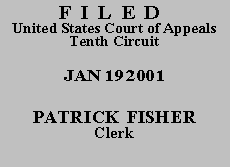

| ANNIELEE GALLEGOS,
Plaintiff-Appellant, v. KENNETH S. APFEL, Commissioner, Social Security Administration, Defendant-Appellee. |
|
Claimant Annielee Gallegos appeals from the district court's order affirming the decision of the Commissioner of Social Security. In that decision, the Commissioner denied Mrs. Gallegos's application for disability insurance benefits under Title II of the Social Security Act. See 42 U.S.C. § 423. We exercise jurisdiction under 42 U.S.C. § 405(g) and 28 U.S.C. § 1291, and affirm.
Our review is limited to determining whether the Commissioner's decision is supported by substantial evidence on the whole record and comports with relevant legal standards. Casias v. Sec'y of Health & Human Servs., 933 F.2d 799, 800-01 (10th Cir. 1991). Claims for disability benefits are evaluated according to the five-step sequential process set forth in 20 C.F.R. § 404.1520. Williams v. Bowen, 844 F.2d 748, 750-52 (10th Cir. 1988). At step four of the process, "the claimant must show that the impairment prevents [him] from performing work he has performed in the past." Id. at 751 (quotation omitted and alteration in original). If the claimant is successful at this stage, then the claimant
has met his burden of proof, establishing a prima facie case of disability. The evaluation process thus proceeds to the fifth and final step: determining whether the claimant has the residual functional capacity (RFC) "to perform other work in the national economy in view of his age, education, and work experience."
Id. (citation and footnote omitted). At step five, the burden shifts to the Commissioner to show that the claimant retains the RFC to do specific jobs. Thompson v. Sullivan, 987 F.2d 1482, 1487 (10th Cir. 1993).
Mrs. Gallegos claimed that she is disabled due to a back injury and its associated pain and other nonexertional impairments. At step four, the administrative law judge (ALJ) determined that she could not return to her past relevant work as a nursing assistant in the medium exertion work category. Appellant's App. at 16. The ALJ concluded, however, that Mrs. Gallegos's allegations that her impairments were of sufficient severity to prevent all sustained work activity were inconsistent with the record and not credible. Id. Claimant does not challenge this credibility finding.
The ALJ determined at step five that, based upon the medical record and her level of daily activity, Mrs. Gallegos retained the RFC to do a full range of sedentary work limited only by the need to be able to change positions while seated, id. at 15, but that "the requirement for position changes does not significantly erode the number of jobs" that Mrs. Gallegos can perform, id. at 17. The ALJ concluded that Mrs. Gallegos is not disabled under Rule 201.28 of the medical-vocational guidelines (the "grids"), 20 C.F.R. Pt. 404, Subpt. P, App. 2. Id. at 15-16.
Citing Thompson, supra, and focusing on the ALJ's finding that Mrs. Gallegos needed to change positions when sitting, Mrs. Gallegos asserts that the ALJ erred in relying on the grids because the ALJ did not make a finding specifically stating that Mrs. Gallegos had no nonexertional impairments. See 987 F.2d at 1488 ("An ALJ may not rely conclusively on the grids unless he finds . . . that the claimant has no significant nonexertional impairment"). We disagree. Although the ALJ did not use the exact words claimant desired, the ALJ did find that claimant's need to change positions because of pain "does not significantly erode the number of jobs" she could perform. Appellant's App. at 17. This was simply another way of stating that Mrs. Gallegos's nonexertional impairment was not significant enough to preclude reliance on the grids.
Mrs. Gallegos also argues that the fact that she has to change positions when sitting is a nonexertional impairment that precludes reliance on the grids. Again, we disagree. Use of the grids is precluded only when a nonexertional impairment limits a claimant's RFC. Glass v. Shalala, 43 F.3d 1392, 1396 (10th Cir. 1994). The need to change positions when sitting is not the same as the need to alternate sitting and standing because the ability to remain seated at a job is not altered by simply shifting position. The record contains substantial evidence to support the ALJ's finding that claimant's nonexertional impairment of the need to change position had no substantial effect on her RFC for sedentary work.
Mrs. Gallegos next argues that the ALJ "dismissed most of the nonexertional impairments" she alleged, Appellant's Br. at 8, but she does not say what those were, other than her need to change positions when sitting. She also claims that it was error for the ALJ to note that she "testified that one of her medications had produced sleepiness," Appellant's App. at 15, without taking into account the limitation that impairment may have on her ability to do a full range of sedentary work. Mrs. Gallegos misinterprets the meaning of the ALJ's statement in light of the record. Mrs. Gallegos testified that she could not sleep unless she was really exhausted or took Paxil to help her sleep at night. Id. at 246. She did not testify that she had to take Paxil during the day such that its sleep-producing effect would affect her ability to do sedentary work. Thus, contrary to claimant's assertion, the ALJ did not find that sleepiness from medications was a nonexertional impairment. We conclude that the ALJ properly relied on the grids in determining that Mrs. Gallegos is not disabled.
The judgment of the United States District Court for the District of Colorado is AFFIRMED.
Entered for the Court
Circuit Judge
*. This order and judgment is not binding precedent, except under the doctrines of law of the case, res judicata, and collateral estoppel. The court generally disfavors the citation of orders and judgments; nevertheless, an order and judgment may be cited under the terms and conditions of 10th Cir. R. 36.3.